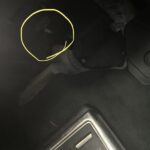Swapping an H22 engine into your Honda Accord? Understanding the alternator wiring is crucial. This guide focuses on using an H22 OBD2 engine with an OBD1 alternator and creating a jumper harness for a seamless integration. We’ll cover key aspects of the process, including pinouts, wiring diagrams, and potential challenges.
Understanding the Need for a Jumper Harness
Honda transitioned from OBD1 (On-Board Diagnostics 1) to OBD2 (On-Board Diagnostics 2) in the mid-90s. This shift brought changes in diagnostic systems and wiring configurations, including alternator control. When using an OBD2 H22 engine in an OBD1 chassis, a jumper harness becomes necessary to bridge the gap between the two systems and ensure proper alternator function. This harness adapts the OBD2 alternator connector to be compatible with the OBD1 wiring harness in your vehicle.
H22 Alternator Wiring Basics
Both OBD1 and OBD2 H22 alternators generally use a similar plug with key wires for charging and voltage regulation. However, the wiring colors and pin locations might differ. Common wires include:
- Charge Wire: This thick wire carries the charging current from the alternator to the battery.
- Ignition Sense Wire: This wire signals the alternator to start charging when the ignition is turned on.
- L (Indicator Lamp) Wire: Connects to the charging system warning light on the dashboard.
Building the H22 OBD2 to OBD1 Alternator Jumper Harness
Creating the jumper harness requires careful attention to detail and accurate wiring. Here’s a general outline of the process:
-
Gather Materials: You’ll need the OBD1 and OBD2 alternator connectors, wiring, soldering iron, heat shrink tubing, electrical tape, and a wiring diagram for both systems. A multimeter is also recommended for verifying connections.
-
Identify Corresponding Wires: Using the wiring diagrams, match the corresponding wires between the OBD1 and OBD2 connectors. Pay close attention to wire colors and functions.
-
Create the Jumper Harness: Solder the corresponding wires together, ensuring proper polarity. Use heat shrink tubing to insulate the soldered connections. Organize the wires neatly and secure them with electrical tape or wire loom.
Common Issues and Troubleshooting
- Alternator Not Charging: Verify all connections are secure and correctly wired. Check fuses and relays related to the charging system.
- Charging System Warning Light Stays On: This indicates a problem with the charging system. Double-check the L wire connection and ensure the alternator is functioning correctly.
- Incorrect Pulley Size: As mentioned in the original article, Prelude and Accord alternators have different pulley sizes. Ensure the correct belt length is used to avoid slippage or excessive tension.
Conclusion
Successfully integrating an H22 OBD2 engine into an OBD1 Honda requires a properly constructed alternator jumper harness. By understanding the wiring principles and following the steps outlined above, you can ensure a reliable charging system for your engine swap project. Always consult specific wiring diagrams for your application to confirm accurate connections. A well-built jumper harness is crucial for a successful and trouble-free H22 swap.

